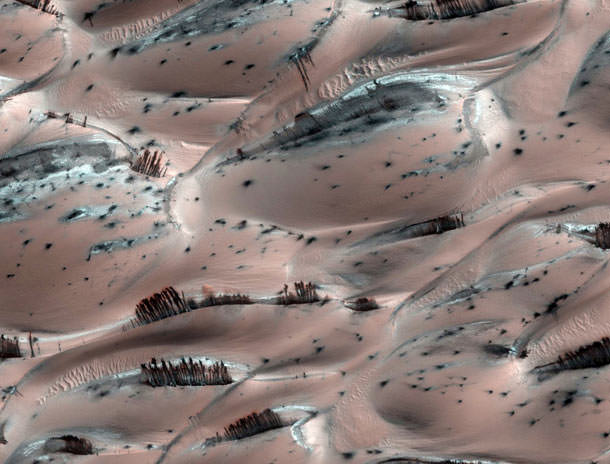[/caption]
Excitingly, we’ve been able to detect the composition of atmospheres on a handful of planets orbiting other stars. But if next-generation space observatories go online within the next couple of decades, some scientists propose using a new technique to determine details such as tree-like multicellular life on extrasolar planets.
While previous studies have discussed the likelihood of detecting life on exoplanets through signs of biogenic gases in the atmosphere, or seeing “glints” of light off oceans or lakes, those technique are limited in that, for example, biogenic gases could be signs of either single-celled or multicellular life – not providing much detail — and as we’ve seen from Titan, glints off planetary bodies do not necessarily come from water-filled lakes.
Researchers Christopher Doughty and Adam Wolf from the Carnegie Institution propose using a technique that Earth-orbiting satellites already use to in order to determine types of crops and land cover, as well as cloud detection, atmospheric conditions and other applications.
Called Bidirectional Reflectance Distribution Function (BRDF), this type of remote sensing determines the causes of differing reflectance at different sun- and view-angles. For example, trees cast shadows on the planet, and the large-scale pattern of shadows would make the light reflected off the vegetation to take on specific brightness and color characteristics.
“BRDF arises from the changing visibility of the shadows cast by objects,” the researchers wrote in their paper, “and the presence of tree-like structures is clearly distinguishable from flat ground with the same reflectance spectrum. We examined whether the BRDF could detect the existence of tree-like structures on an extrasolar planet by using changes in planetary albedo as a planet orbits its star.”

They used a computer model to simulate vegetation reflectance at different planetary phase angles and added both simulated and real cloud cover to calculate the planetary albedo for a vegetated and non-vegetated planet with abundant liquid water.
Depending on how accurately planetary cloud cover can be resolved, as well as the sensitivity instruments on proposed missions such as the Terrestrial Planet Finder, this technique could theoretically detect tree-like multicellular life on exoplanets in about 50 nearby stellar systems.
The angles of the spacecraft, the planet and its sun would have to be taken into account but the team says these characteristics would change in predictable ways over time, producing a detectable pattern.
If vegetation on the exoplanet was wide¬spread enough, it would affect the reflective properties of the whole planet.
“We found that even if the entire planetary albedo were rendered to a single pixel, the rate of increase of albedo as a planet approaches full illumination would be comparatively greater on a vegetated planet than on a non-vegetated planet,” they said.
Doughty and Wolf’s paper appeared in the journal Astrobiology.


Wow, this is big news! However, can next generation telescopes really have the resolving power to detect the effects of volumetric light scattering? Present telescopes can barely see the largest and closest planets in the infrared! It seems like we might be getting a little ahead of ourselves here.
Also, 10 lightyears is a little short. How many potential target systems are there? Alpha Centauri system and Epsilon Eri are the only two that come to mind here. Of those, only Epsilon Eri has been confirmed to have planets (thought I figure Centauri A/B have a good chance of rockies up to 1 Au).
If this method could be beefed up to give us reliable results within 30 light years, then we are on to something.
UF
“Trees on an alien world? No, a dune field on Mars with sand flows. Credit: NASA/JPL/U of Arizona”
If this is supposed to be picture of the Martian landscape, what the heck is that outcropping from the sand???
Color me ‘tree impressed’, as the french say!
I’m not sure I share Uncle Fred’s informed pessimism. A priori 50 planets would IIRC have ~ 1/4th or 10-20 Earth analogs within the habitable zone, if the current statistics apply; most M stars on average, but they are looking up as livable. (AFAIU tidally locked habitable planets may have reasonable magnetic fields despite slow liquid core rotation. And they *do* support the latest found IR (!) photosynthetic system.)
@ RB:
What you see as “outcropping” are sand flows, as the text says:
“This image looks remarkably like groves of trees growing among Martian dunes. But, the trees are an optical illusion. They are actually dark streaks of sediment on the downwind side of the dunes. They were created by escaping gas from the evaporating carbon dioxide ice below. The bottom of the ice melts into vapor and moves toward holes in the ice, carrying dark sediment along with it that is then deposited when the gas escapes.”
[UT and/or BA has a thorough article on the illusion, but I couldn’t find it.]